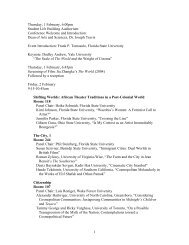Visibility now: Historicizing foreign presences in translation - English ...
Visibility now: Historicizing foreign presences in translation - English ...
Visibility now: Historicizing foreign presences in translation - English ...
You also want an ePaper? Increase the reach of your titles
YUMPU automatically turns print PDFs into web optimized ePapers that Google loves.
Downloaded by [Florida State University], [Anne Coldiron] at 07:12 30 March 2012<br />
Translation Studies 191<br />
manuscripts were not s<strong>in</strong>gular and godlike; <strong>in</strong>stead, textual production was radically<br />
collaborative and <strong>in</strong>volved many roles and functions, from those who scraped the<br />
sk<strong>in</strong>s to those who translated words, from compilatores to illum<strong>in</strong>ators. Specific roles<br />
and hierarchies of production came to be established and were announced (and<br />
perpetuated) <strong>in</strong> certa<strong>in</strong> metatextual and paratextual sites <strong>in</strong> the manuscripts. The<br />
articulation of these roles and hierarchies guaranteed, <strong>in</strong> some sense, the validity and<br />
value of the work and the reliability of any given text or copy of the work. For<br />
<strong>in</strong>stance, the accessus ad auctores was essentially an open<strong>in</strong>g statement about the<br />
authors, glossators, commentators, scribes and others <strong>in</strong> the l<strong>in</strong>e of textual<br />
production and transmission for the given work and the particular copy of it<br />
(Sanford 1934; Nardi 1961; Suerbaum 1998; Gilbert-Santamaría 2005, 412 13). An<br />
articulated genealogy and hierarchy of production warranted the value and validity<br />
of the text. Invisibility, <strong>in</strong> short, would have worked directly aga<strong>in</strong>st a chief goal for<br />
medieval texts, the establishment of auctoritas.<br />
With<strong>in</strong> this general and well-motivated visibility of textual producers, medieval<br />
texts developed certa<strong>in</strong> conventions of expression for the translator’s visibility. Along<br />
with the accessus ad auctores, the mention of translators <strong>in</strong> <strong>in</strong>cipits, explicits, envois<br />
and asides, and the common use of exegetical glosses and apparatus <strong>in</strong> certa<strong>in</strong> genres<br />
all tended to display the translator’s role <strong>in</strong> transmitt<strong>in</strong>g the work, often enough <strong>in</strong><br />
the first person. Specific translators’ topoi became conventional: translators usually<br />
claimed their humble servitude and fidelity to the work and to its auctor. They<br />
claimed their care for translat<strong>in</strong>g each word and/or for reproduc<strong>in</strong>g the sense and<br />
<strong>in</strong>tention of author, even if <strong>in</strong>dividual words could not be precisely the same.<br />
(Sometimes this issue <strong>in</strong> l<strong>in</strong>guistic difference was blamed on our post-Babel<br />
fallenness.) But Rita Copeland and scholars follow<strong>in</strong>g her Rhetoric, Hermeneutics,<br />
and Translation <strong>in</strong> the Middle Ages have carefully demonstrated how often these<br />
translators’ claims covered their strong <strong>in</strong>terventions and <strong>in</strong>terpretations (among<br />
many others, Copeland 1991, 2 8, 37 8, 62, 87 126, 179 202, 221 9; Franco 2009;<br />
Yucesoy 2009). Likewise, translators conventionally claimed humility and modesty<br />
even when, <strong>in</strong> the case of famous translators or authors, this was clearly<br />
dis<strong>in</strong>genuous. Medieval translators may have been cagey, but they were not <strong>in</strong>visible<br />
<strong>in</strong>deed they were highly visible <strong>in</strong> specific ways, with claims and attitudes <strong>in</strong>tended<br />
to <strong>in</strong>sure the validity of the present text, the venerability of the antecedent work, and<br />
its truth value overall. So <strong>in</strong> medieval texts, visibility, not <strong>in</strong>visibility, was the<br />
fetishized th<strong>in</strong>g, precisely the opposite case of what Venuti f<strong>in</strong>ds <strong>in</strong> the past two<br />
centuries’ demands for ‘‘smooth’’, <strong>in</strong>visible <strong>translation</strong>s that efface the labor and art<br />
of the translator as well as the <strong>foreign</strong>ness of the work. This is not to say that<br />
medieval translators had it any better: translators, like compilatores, and perhaps a<br />
little better than scriptores, were always lower <strong>in</strong> the textual-production food cha<strong>in</strong><br />
than auctores. Still, the need for the translator’s visible work was never <strong>in</strong> doubt <strong>in</strong><br />
medieval <strong>translation</strong>: <strong>in</strong> a literary system committed to preservation, cont<strong>in</strong>uity,<br />
hierarchy, authority and venerability, the translator’s visibility was a crucial mark of<br />
value.<br />
After pr<strong>in</strong>t<strong>in</strong>g technology and other changes comb<strong>in</strong>ed to alter irrevocably the<br />
landscapes of both sociopolitical and textual authority, different values obta<strong>in</strong>ed,<br />
entail<strong>in</strong>g shifts <strong>in</strong> the mean<strong>in</strong>g of visibility and <strong>in</strong>visibility <strong>in</strong> <strong>translation</strong>s. While we<br />
can still f<strong>in</strong>d translators’ fidelity and humility topoi <strong>in</strong> early modern paratexts, as the<br />
age of imitatio and sprezzatura unfolds, two concomitant ideas develop: first, that




